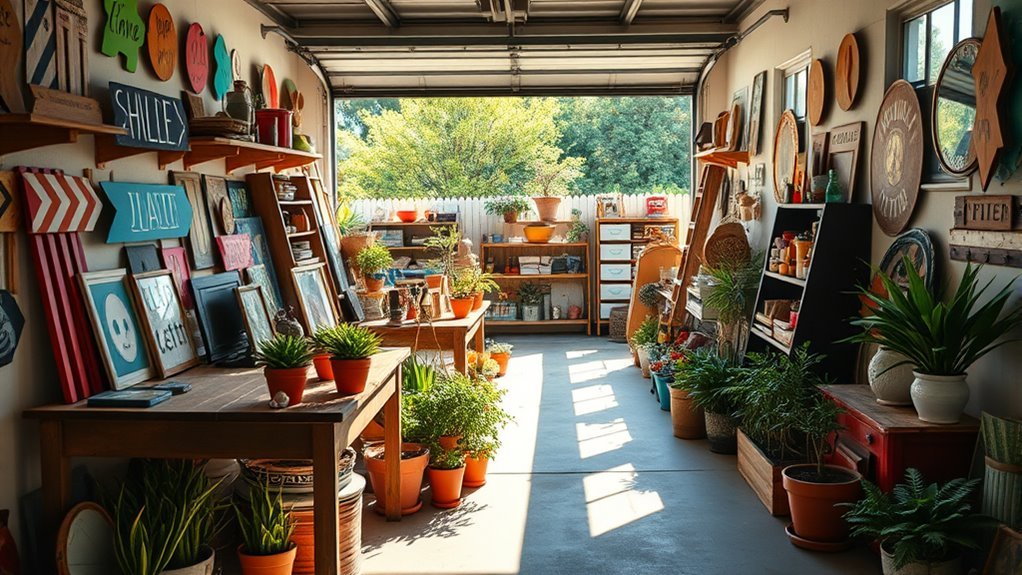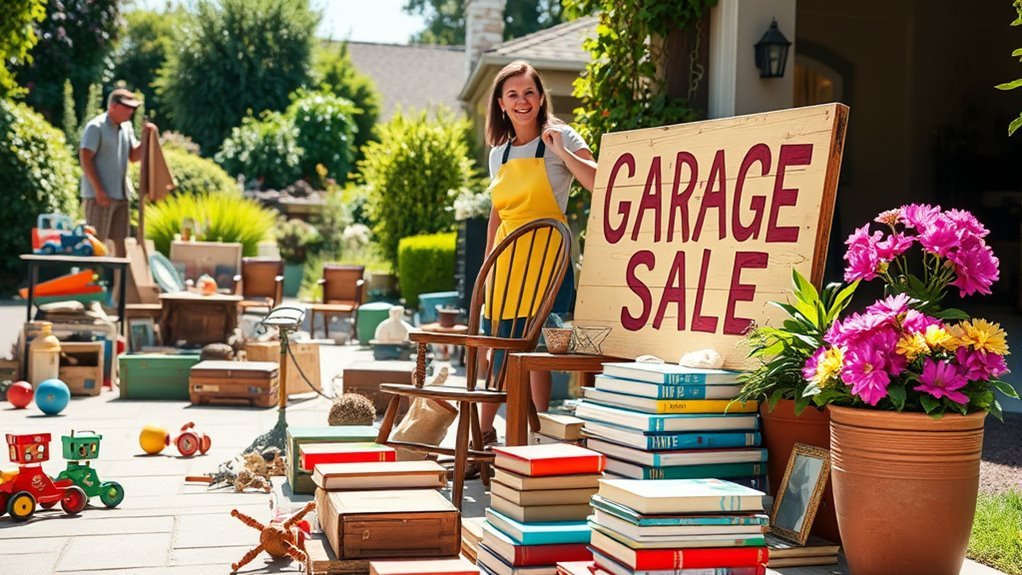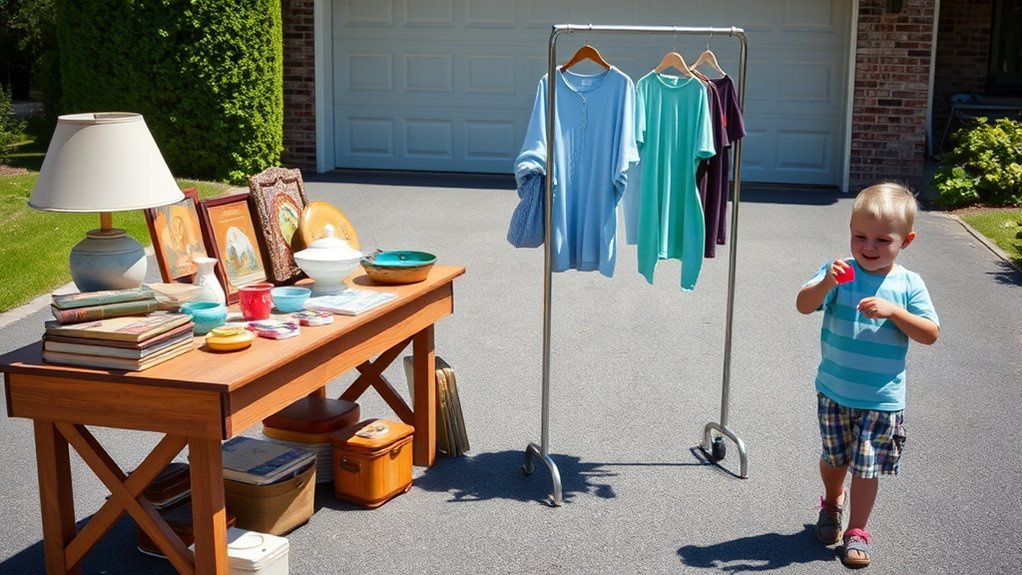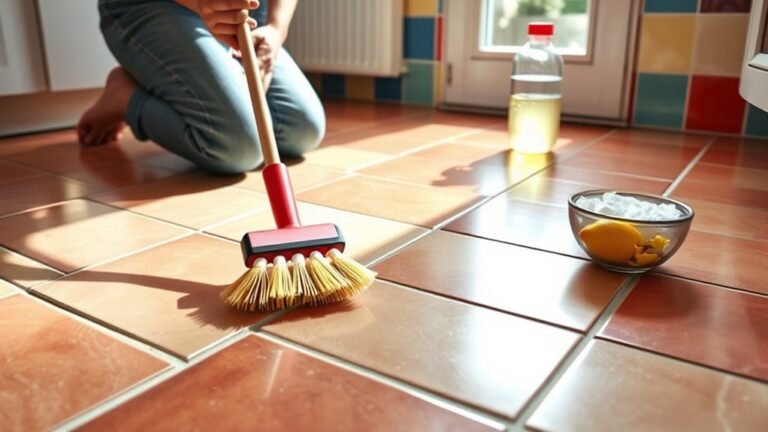Preparing Your Home for a Garage Sale
To prepare your home for a garage sale, start by sorting items and decluttering to reclaim space. Price goods fairly and organize them clearly to attract buyers. Create bold signage and advertise widely to draw in crowds. Set up an inviting, safe space with a comfortable checkout area, and plan for weather changes to keep things running smoothly. Keep these basics in mind, and you’ll be ready to make your sale a success. There’s more to explore to fine-tune your setup.
Sorting and Decluttering Your Items

Before you set a date for your garage sale, start by sorting and decluttering your items. Break everything down into clear item categories—clothing, electronics, books, tools, and so on. This helps you see what you truly want to part with and makes the sale smoother for buyers who crave easy browsing. As you sort, be honest with yourself about what you’ll actually use again. Anything you decide not to sell? Explore donation options. Giving those items a new life through donation not only frees up your space but also supports causes you care about. This process is about reclaiming your freedom from clutter and simplifying your surroundings, setting the stage for a successful, stress-free garage sale day.
Pricing Your Garage Sale Goods
To price your garage sale items effectively, start by researching what similar goods are selling for in your area. Be sure to factor in the condition of each item when setting prices. Using clear price tags will help buyers know exactly what to expect and speed up the sale.
Research Comparable Prices
Setting the right price can make or break your garage sale success. To find that sweet spot, start by checking online marketplaces and local classifieds for items similar to yours. This research helps you understand what buyers are willing to pay and keeps your prices competitive. Don’t just guess—look up the exact brands, models, and conditions to get accurate comparisons. Remember, pricing too high might scare off buyers, while pricing too low could undervalue your stuff. By investing a little time in researching comparable prices, you’ll feel more confident and free to set prices that sell quickly and fairly. This way, you maximize your earnings without the hassle of constant negotiations.
Consider Item Condition
Take a close look at each item’s condition before pricing it for your garage sale. Your freedom to set fair prices comes from knowing exactly what you’re selling. Conduct a thorough quality assessment to determine wear, damage, or functionality issues. Use item grading to categorize goods—like “like new,” “good,” or “fair” condition—so buyers understand the value. This honest approach helps you price confidently and attract serious shoppers. Remember, an accurate quality assessment prevents overpricing items that have flaws, while highlighting those worth more. When you’re clear about condition, you free yourself from guesswork and build trust with buyers who appreciate straightforward deals. This simple step is key to a smooth, successful garage sale.
Use Clear Price Tags
Once you’ve determined the condition and fair value of your items, it’s important to communicate prices clearly to your buyers. Using the right price tag materials, like sturdy cardstock or waterproof labels, guarantees your tags stay readable throughout the sale. Choose tag placement strategies that make prices visible without damaging your items—tie tags to handles or corners, or use removable adhesive dots for flat surfaces. Clear price tags reduce confusion and speed up sales, freeing you from constant price negotiations. When buyers see straightforward pricing, they’re more likely to feel confident and make quick decisions. Keep your tags neat and consistent so your garage sale feels organized and professional, giving you the freedom to focus on the fun of selling rather than haggling over every item.
Organizing and Displaying Merchandise
To make your garage sale a success, you’ll want to arrange your items neatly and logically. Start by grouping similar merchandise together—clothes with clothes, books with books. This merchandise arrangement helps buyers find what they want quickly, giving you more freedom to relax and enjoy the day. Use smart display techniques like stacking smaller items in clear containers or hanging clothes on a portable rack to save space. Keep eye-catching or high-value items at eye level to attract attention effortlessly. Don’t clutter tables; instead, leave room so customers can browse comfortably. A well-organized setup not only maximizes your selling potential but also creates a welcoming atmosphere, making your garage sale both efficient and enjoyable for everyone involved.
Creating Effective Signage

You’ll want to use clear, bold fonts on your signs so they’re easy to read from a distance. Bright, eye-catching colors will help grab attention and draw people in. Make sure to place your signs strategically around your neighborhood to guide shoppers right to your sale.
Clear and Bold Fonts
A sign with clear and bold fonts grabs attention and makes your garage sale easy to find. When creating your signage, choose font styles that are simple and straightforward—think sans-serif fonts like Arial or Helvetica. These are easier to read from a distance and won’t confuse potential buyers. Vary your text sizes strategically: make your main message, like “Garage Sale,” large and bold, while details such as the date, time, and address should be slightly smaller but still clear. Avoid fancy or script fonts that slow down reading. Remember, your goal is to offer freedom to wanderers by guiding them effortlessly to your sale. Clear, bold fonts guarantee your signs communicate efficiently, letting you focus on enjoying the day instead of chasing customers down.
Bright and Eye-Catching Colors
Although clear fonts draw attention, bright and eye-catching colors make your signs impossible to miss. When you use colorful decorations and vibrant displays, you create an inviting atmosphere that speaks freedom and fun. Choose colors that contrast well for easy reading and grab the eye from a distance. Here’s a quick guide to help you pick the best colors for your garage sale signs:
| Background Color | Text Color | Effect |
|---|---|---|
| Yellow | Black | High contrast |
| Neon Green | Dark Blue | Energetic vibe |
| Bright Orange | White | Bold and clear |
Use these color combos to craft signs that shout “Come here!” and make your sale stand out without overwhelming passersby.
Strategic Sign Placement
Three key spots can make or break your garage sale’s visibility: intersections, busy roads, and neighborhood corners. You want to place your signs where they catch the eye without cluttering the space. Use bold colors and guarantee sign visibility by avoiding obstructions like trees or parked cars. Incorporate directional arrows to guide buyers smoothly to your location, especially if your street isn’t directly off a main road. Position signs at a readable height and angle so drivers and pedestrians can spot them quickly. Remember, every sign is a beacon of freedom, inviting people to explore treasures you’re ready to share. With thoughtful placement, you’ll maximize traffic without relying on costly ads, making your garage sale both efficient and liberating.
Advertising Your Garage Sale

Effective advertising can make or break your garage sale, so you’ll want to reach as many potential buyers as possible. To set yourself free from slow sales, try these strategies:
- Post on social media platforms like Facebook Marketplace or local groups to tap into your network instantly.
- Use community boards at libraries, coffee shops, or grocery stores—these local spots attract engaged neighbors.
- Create clear, eye-catching flyers with essential details and place them in high-traffic areas.
- List your sale on online classified sites such as Craigslist to widen your audience beyond your neighborhood.
Preparing Your Home and Garage Space
Now that you’ve spread the word about your sale, it’s time to get your home and garage ready. Focus on garage organization first—clear out clutter and group items by category so buyers can browse freely. Use shelves, hooks, or bins to maximize space optimization, creating an inviting, open layout that encourages exploration without feeling cramped. Keep pathways clear to enhance flow and safety. Inside your home, tidy up entrance areas to welcome visitors comfortably. Remember, a well-organized space not only showcases your items better but also reflects your freedom to let go and simplify. By optimizing your garage and home setup, you set the stage for a smooth, successful sale that feels effortless and liberating for both you and your buyers.
Setting Up a Comfortable Checkout Area
Creating a designated checkout area helps keep the sale running smoothly and makes transactions easier for both you and your buyers. To maximize checkout comfort and offer flexible payment options, consider these steps:
- Choose a shaded, quiet spot close to your sale items to reduce distractions and keep you comfortable.
- Set up a sturdy table and chair for you to sit, making transactions less tiring.
- Provide clear signage for prices and accepted payment methods, including cash, cards, or mobile pay.
- Keep change, receipts, and bags organized for quick, hassle-free checkout.
Planning for Weather and Safety Considerations
Once your checkout area is set, it’s important to think about how weather and safety might affect your garage sale. Weather preparedness is key—have tarps or pop-up tents ready to protect your items and shoppers from unexpected rain or intense sun. Secure your setup with weights or stakes to prevent tents from blowing away. Safety measures are just as important. Keep walkways clear to avoid trips and falls, and position heavy or fragile items low and stable. If you’re using extension cords, tape them down or cover them to prevent accidents. Make certain your driveway or yard is well-lit if your sale extends into the evening. By planning for weather and safety considerations, you make your garage sale enjoyable and hassle-free for everyone, giving you the freedom to focus on selling.
Frequently Asked Questions
What Time of Day Do Garage Sales Usually Attract the Most Buyers?
Think of morning hours during weekend sales as the golden hour for buyers—you’ll catch the early birds who love snagging the best deals before the crowd swarms in. If you want to maximize your chances, start bright and early, around 7 or 8 AM, when shoppers are fresh and enthusiastic. This timing taps into their freedom to browse leisurely, making your sale a lively spot full of energy and opportunity.
Can I Hold a Garage Sale Without a Permit in My Neighborhood?
You might be able to hold a garage sale without a permit, but it really depends on your local garage sale regulations and neighborhood guidelines. Some places are pretty relaxed, letting you set up freely, while others require a permit to keep things orderly. It’s best to check with your city or homeowners association so you won’t run into any trouble. That way, you can enjoy your sale without restrictions holding you back.
How Far in Advance Should I Start Advertising My Garage Sale?
You should start your advertising strategies about two weeks before your garage sale to maximize interest without tiring potential buyers. This promotion timeline gives you enough freedom to spread the word through social media, community boards, and local classifieds. Don’t wait too long, or people might forget; starting early lets you build excitement and adjust your approach based on the response, giving you control over a successful, well-attended sale.
What Payment Methods Should I Accept Besides Cash?
Think of cash as the sturdy key that opens your sale’s door, but don’t forget the digital keys—digital payments and mobile wallets. Accepting these lets you release freedom for buyers who prefer swiping to jingling coins. You’ll reach more people and make transactions smoother. Apps like Venmo or PayPal can be lifesavers, freeing you from handling cash and offering convenience that fits today’s fast-paced, on-the-go lifestyle.
How Do I Handle Unsold Items After the Garage Sale?
Once your garage sale wraps up, don’t stress over unsold items. You can donate them to local charities or thrift stores, freeing up space and supporting good causes. If you’re not ready to part with certain things, consider storage solutions like bins or renting a small unit. This way, you keep your freedom to decide later without clutter weighing you down. It’s all about staying flexible and stress-free.






